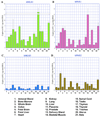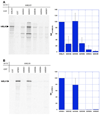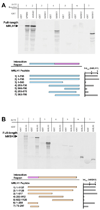Evidence that hMLH3 functions primarily in meiosis and in hMSH2-hMSH3 mismatch repair
- PMID: 19483466
- PMCID: PMC3010362
- DOI: 10.4161/cbt.8.14.8886
Evidence that hMLH3 functions primarily in meiosis and in hMSH2-hMSH3 mismatch repair
Abstract
The MutS (MSH) and MutL (MLH) homologs are conserved proteins that function in mismatch repair (MMR) and meiosis. We examined mRNA and protein expression of hMLH3 compared to other human MSH and MLH in a panel of human tissues and the HeLa cell line. Quantitative PCR suggests that MSH and MLH transcripts are expressed ubiquitously. hMLH3 mRNA is present at low levels in numerous tissues. Protein expression appears to correlate with a threshold of mRNA expression with hMLH3 present at high levels in testis. In addition, we have found and mapped interactions between hMLH1 and hMLH3 with hMSH3. These data are consistent with yeast studies and suggest a role for hMLH3 in meiosis as well as hMSH2-hMSH3 repair processes and little if any role in Hereditary Non-Polyposis Colorectal Cancer (HNPCC).
Figures






Comment in
-
Elucidating the role of human mismatch repair factor hMLH3.Cancer Biol Ther. 2009 Jul;8(14):1421-3. doi: 10.4161/cbt.8.14.9067. Epub 2009 Jul 20. Cancer Biol Ther. 2009. PMID: 19502813 No abstract available.
References
-
- Lynch HT, de la Chapelle A. Hereditary colorectal cancer. N Engl J Med. 2003;348:919–932. - PubMed
-
- Boland CR, Fishel R. Lynch syndrome: form, function, proteins, and basketball. Gastroenterology. 2005;129:751–755. - PubMed
-
- de Jong MM, Hofstra RM, Kooi KA, Westra JL, Berends MJ, Wu Y, et al. No association between two MLH3 variants (S845G and P844L)and colorectal cancer risk. Cancer Genet Cytogenet. 2004;152:70–71. - PubMed
-
- Hienonen T, Laiho P, Salovaara R, Mecklin JP, Jarvinen H, Sistonen P, et al. Little evidence for involvement of MLH3 in colorectal cancer predisposition. Int J Cancer. 2003;106:292–296. - PubMed
-
- Korhonen MK, Vuorenmaa E, Nystrom M. The first functional study of MLH3 mutations found in cancer patients. Genes Chromosomes Cancer. 2008 - PubMed
Publication types
MeSH terms
Substances
Grants and funding
LinkOut - more resources
Full Text Sources
Other Literature Sources
